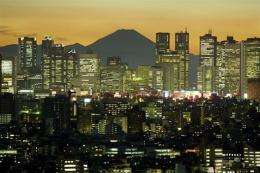Radium 'likely cause' of Tokyo radiation hotspot

Japanese authorities believe radium was to blame for a radiation hotspot at a Tokyo supermarket, a local city office said on Tuesday, in another scare for a nation still on edge over Fukushima.
Workers wearing protective suits and goggles drilled into the asphalt at one of the two hotspots where inspectors last week detected alarming levels of radiation -- up to 10 microsieverts per hour -- one metre (three feet) above the surface of the ground.
Despite public worries about how far contamination has spread from the crippled Fukushima atomic power plant, authorities believe radium -- a substance not released in the disaster -- is likely the cause of the hotspots, the city office said.
"The science and technology ministry said it is highly possible that radium 226 is the source of radiation," the Setagaya ward office said in a statement.
"The ministry also said this case is not linked to the accident at the Fukushima Daiichi nuclear power plant," it said, adding inspectors plan to continue investigating the hotspots over the next two weeks.
The radiation levels of the hotspots are much higher than the 20 millisieverts per year government threshold that would prompt evacuation, though no evacuation was required as the contamination was highly localised.
The statement gave no indication of the source of the radium.
The finding came weeks after Japanese authorities discovered old containers of radium powder, likely used for luminous paint, under the floorboards of a house in Setagaya, western Tokyo.
Radiation fears are a daily fact of life in many parts of Japan following the earthquake and tsunami-sparked meltdowns at the Fukushima plant, with reported cases of contaminated water, beef, vegetables, tea and seafood.
Radiation levels as high as those in the evacuation zone around the Fukushima nuclear plant have been detected in an eastern Tokyo suburb, which are likely linked to the disaster.
Levels of two microsieverts per hour were detected one metre above the surface of the soil in a vacant lot in Kashiwa city, Chiba prefecture.
Inspectors from the science and technology ministry believe the hotspot was created after radioactive caesium carried by rain water became concentrated in a small area because of a broken gutter.
Variable winds, weather and topography result in an uneven spread of contamination, experts say, and radioactive elements tend to concentrate in places where dust and rain water accumulate such as drains and ditches.
The March 11 earthquake triggered a tsunami that tore into Japan's northeast coast, leaving 20,000 people dead or missing, and sparking meltdowns and explosions Fukushima.
The subsequent release of radiation forced the evacuation of tens of thousands from a 20 kilometre (12 mile) radius from the plant and spots beyond, in the world's worst nuclear accident since the Chernobyl disaster in 1986.
(c) 2011 AFP


















